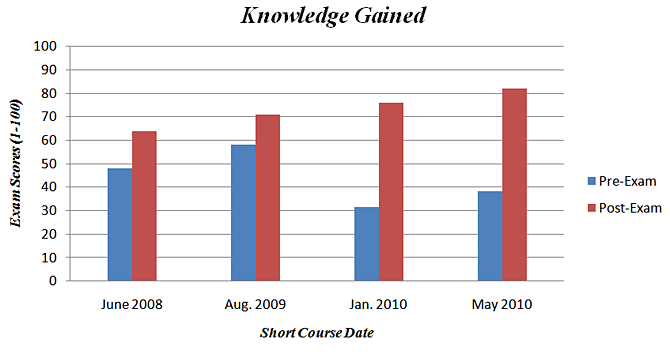Texas Watershed Planning Short Course Materials
-
January 12-16, 2009
-
Agenda, Participants
| Monday, January 12, 2009 |
| Wagner |
Introduction |
Rush
|
Nine Elements of a Watershed Protection Plan |
| Banks,
Carter,
Rush,
Wendt |
Perspectives on WPPs |
|
MacPherson |
Working with Stakeholders to Move the Process Forward |
| Dictson |
Partnership Building Experiences in Plum Creek |
| Tuesday, January 13, 2009 |
|
MacPherson |
Using Outreach to Develop & Implement WPPs - Element E |
| Wendt |
Defining the Scope of the WPP |
| Dictson/Wagner |
Gathering data to assess your watershed |
|
T. Davenport |
Analyzing Data to Characterize Your Watershed |
|
MacPherson |
Communicating to Diverse Audiences to Achieve Your Goals |
|
McDonnell |
Web-Based Tools for Watershed Assessment & Management |
| L. Hamilton |
Revising the Texas Water Quality Standards |
| Lamb |
Expectations for Element A |
| Wednesday, January 14, 2009 |
|
Hauck |
Overview of Models for Estimating Pollutant Loads &
Reductions |
|
Kenimer |
Simple Tools for Estimating Loads and Load Reductions |
|
Harmel |
Perspectives on Monitoring, Modeling and Decision Making |
| Wendt |
Expectations for Element B |
| Kenimer |
Pollutant Fate and Transport Mechanisms |
| T.
Davenport |
Urban NPS Measures |
| Wagner |
Agricultural NPS Measures |
| Lesikar |
Wastewater Treatment Systems |
| Thursday, January 15, 2009 |
|
Thornton |
Other Approaches to Managing Pollutant Sources |
| Wolfe |
Cedar Creek Reservoir Case Study |
| Rush |
Overview and Expectations for Element C |
| Dictson |
Texas Watershed Steward Program |
|
T. Davenport |
Targeting Critical Areas and Scheduling Implementation |
|
T. Davenport |
Developing Interim Milestones & Criteria to Measure
Progress |
|
Hauck |
Designing & Implementing Effectiveness Monitoring - Element
I |
|
Pinchback |
Using Volunteer Monitoring For Assessment and Outreach |
| Rush |
Expectations for Element D |
| Banks |
Cost - Benefit Analysis in Hickory Creek |
| Thornton |
Connecting with the Community |
| Friday, January 16, 2009 |
| Jarocki |
Financing Watershed Implementation |
| Dictson |
Putting It All Together |
| Thornton |
Implementing your WPP |
-
June 2-6, 2008
-
Agenda, Participants
| Monday, June 2, 2008 |
| Wagner |
Introduction |
| Lehman |
Nine Elements of a Watershed Protection Plan |
| Rush/Wendt |
State and Federal Perspectives on WPPs |
| Lehman |
EPA Watershed Plan Builder |
| MacPherson |
Working with Stakeholders to Move the Process Forward |
| Tuesday, June 3, 2008 |
| MacPherson |
Using Outreach to Develop & Implement WPPs - Element E |
| Dictson |
Partnership Building Experiences in Plum Creek |
| MacPherson |
Communicating to Diverse Audiences to Achieve Your Goals |
| Lehman |
Web-Based Tools for Watershed Assessment & Management |
| Wendt |
Defining the Scope of the WPP |
| Dictson/Hauck/Wagner |
Gathering data to assess your watershed |
| Kenimer |
Analyzing Data to Characterize Your Watershed |
| Lamb |
Expectations for Element A |
| Wednesday, June 4, 2008 |
| Hauck |
Overview of Models for Estimating Pollutant Loads &
Reductions |
| Kenimer |
Spreadsheet/Time Variable Models |
| Harmel |
Perspectives on Monitoring, Modeling and Decision Making |
| Miranda |
Setting Goals & Identifying Load Reductions Needed |
| Wendt |
Expectations for Element B |
| Kenimer |
Pollutant Fate and Transport Mechanisms |
| Wagner/Wendt |
Agricultural NPS Measures and WQMPs |
| Davenport |
Urban NPS Measures |
|
Miranda |
Wastewater Treatment Systems |
| Thornton/Rast |
Other Approaches to Managing Pollutant Sources |
| Thornton/Rast |
Prioritizing and Selecting Management Measures |
| Thursday, June 5, 2008 |
| Rush |
Overview and Expectations for Element C |
| Davenport |
Targeting Critical Areas and Scheduling Implementation |
| Davenport |
Developing Interim Milestones & Criteria to Measure
Progress |
| Hauck |
Designing & Implementing Effectiveness Monitoring - Element
I |
| Mendelman |
Using Volunteer Monitoring For Assessment and Outreach |
| Peterson |
Texas Watershed Steward Program |
| Jarocki |
Financing Watershed Implementation |
| Rush/Wendt |
Expectations for Element D |
| Friday, June 6, 2008 |
| Wagner/Wendt |
Putting It All Together - Then What? |
What previous participants say about the Texas Watershed Planning Short Course:
"Thanks again for assembling another great training"
"Great job AgriLife folks! Thanks for all of your hard work putting this course together in a condensed version, while retaining essential pieces. Very well done."
"Thank you for the immense amount of work that went into presenting this course! So many great people."
Knowledge gained in previous Texas Watershed Planning Short Courses:
The Texas Watershed Planning Short Courses provide guidance on stakeholder coordination, education, and outreach; meeting the U.S. Environmental Protection Agency's nine key elements of a watershed protection plan; data collection and analysis; and the tools available for plan development.

